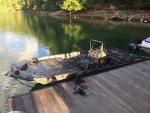I have a Triton 1756 center console w/ Optimax 75. The previous owner had "Beavertrail" pods added to the transom.
I like how the boat takes off quickly and with little bow rise, but I think the pods might have been installed at the wrong angle. Once on plane, they drag heavily and prevent the engine trim from being useful. The end result is the 75Hp lightweight 17ft boat has a top speed much lower than I would expect, ~22-24mph.
Should I suspect this is due to the installation of the pods, or is this typical of all duck boat pods?
I like how the boat takes off quickly and with little bow rise, but I think the pods might have been installed at the wrong angle. Once on plane, they drag heavily and prevent the engine trim from being useful. The end result is the 75Hp lightweight 17ft boat has a top speed much lower than I would expect, ~22-24mph.
Should I suspect this is due to the installation of the pods, or is this typical of all duck boat pods?



